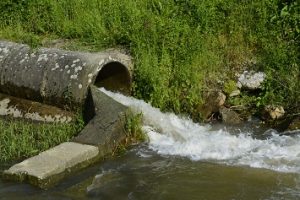If your facility is covered under the U.S. Environmental Protection Agency’s (EPA) 2015 Multi-Sector General Permit for stormwater discharges associated with industrial facilities (MSGP), your electronic annual report is due by January 30, 2018, covering the period up to December 31, 2017. And, it’s time to get ready for next year’s report.

Who Has to Submit a Report?
The 2015 MSGP only impacts areas of the country where the EPA remains the permitting authority over states. Industrial facilities in Massachusetts, New Hampshire, New Mexico, Idaho, and Washington, D.C., are impacted, as well as those entities in most U.S. territories, Indian Country lands, and a few federally operated facilities in Colorado, Delaware, Vermont, and Washington. Certain oil and gas activities in Oklahoma and Texas must also abide by the federal industrial stormwater permit.
However, even states that have their own stormwater general permits must adopt permits that are at least as strict as the federal. A quick look at a compliance calendar for 2018 shows that many states require the submission of at least industrial stormwater discharge monitoring reports (DMRs) in January. Some require the annual report in January. By clicking through the calendar, you can see when your state requires an annual industrial stormwater report.
The What and Where
The annual report should contain a summary of the past year’s routine facility inspections, quarterly visual assessments, any average benchmark monitoring exceedances, a summary of corrective actions taken or outstanding, and any incidents of noncompliance. The annual report must include a signed certified statement and be uploaded electronically to EPA’s NPDES e-reporting tool (NeT).
All monitoring data collected must be submitted to the EPA using EPA’s NetDMR no later than 30 days after you have received your complete laboratory results for all monitoring outfalls for the reporting period. Anyone required to submit discharge monitoring reports (DMRs) may use NetDMR after requesting and receiving permission from their permitting authority.
A map and table below show which states use NetDMR, or a state electronic discharge monitoring report (state eDMR) system.
Sampling: Start the New Year on the Right Foot
As 2018 approaches, you need to start planning for your stormwater sampling requirements for the year so that you are prepared for your reporting requirements.
Begin by paying attention to weather forecasts for your area so that you know when a measurable storm event might happen. A “measurable storm event” is any storm or snowmelt event that creates an actual discharge from your facility. Your industrial stormwater permit should tell you the approximate schedule and number of measurable storm events you have to monitor.
Have Everything Ready
Critical supplies to have ready for stormwater sampling include:
- Clean, sterilized sample bottles that are the appropriate size for the parameter to be analyzed. Glass bottles must be used for oil and grease samples, and plastic containers may be used for all other types of samples. Bottle caps must be lined with Teflon® or aluminum.
- Additional glass or clear plastic bottles for any required visual assessments.
- Monitoring forms.
- A clipboard.
- If needed, a pole for attaching sample bottles with any necessary attachment clips or strapping tape.
- Safety equipment, including a first-aid kit.
- Hand sanitizers.
- A carrying case or backpack for sampling equipment.
- Powder-free, disposable nitrile or latex gloves. (Note: Do not use powdered gloves because they may contaminate the samples.)
- Permanent pens or markers that can write on wet surfaces.
- Foul-weather gear, including footwear appropriate for the conditions at the sampling locations.
- A cooler and ice or ice packs for storing and preserving the samples for transport to the lab.
- A waterproof field notebook or field forms for the sampling records.
- Litmus paper to measure pH and appropriate chemical preservatives for adding to sample bottles.
Other supplies you may want to have on hand include:
- Sodium bicarbonate if using acid preservative additives;
- A graduated stick to measure water depth;
- Mosquito repellent;
- A flashlight in case of sudden loss of light or darkness under storm conditions;
- Flagging tape for marking access to remote or overgrown locations; and
- A camera to record evidence of potential pollutants or sampling conditions and record the sampling location can help you find the same spot for subsequent sampling events.
Finally, make sure you have a site-specific stormwater sampling checklist to help with consistency and continuity across sampling events. Since stormwater sampling is not a regular part of our facility’s workload, a checklist that includes things to prepare before sampling, types and frequency of sampling activities, and sampling locations will help you remember from quarter to quarter. Keep the checklist up to date. It could prove invaluable as you gain experience with sampling.
Changes are afoot for the next EPA industrial stormwater MSGP and, therefore, for your state general permit. Check tomorrow’s Advisor to see possible changes and how you can prepare for them.
